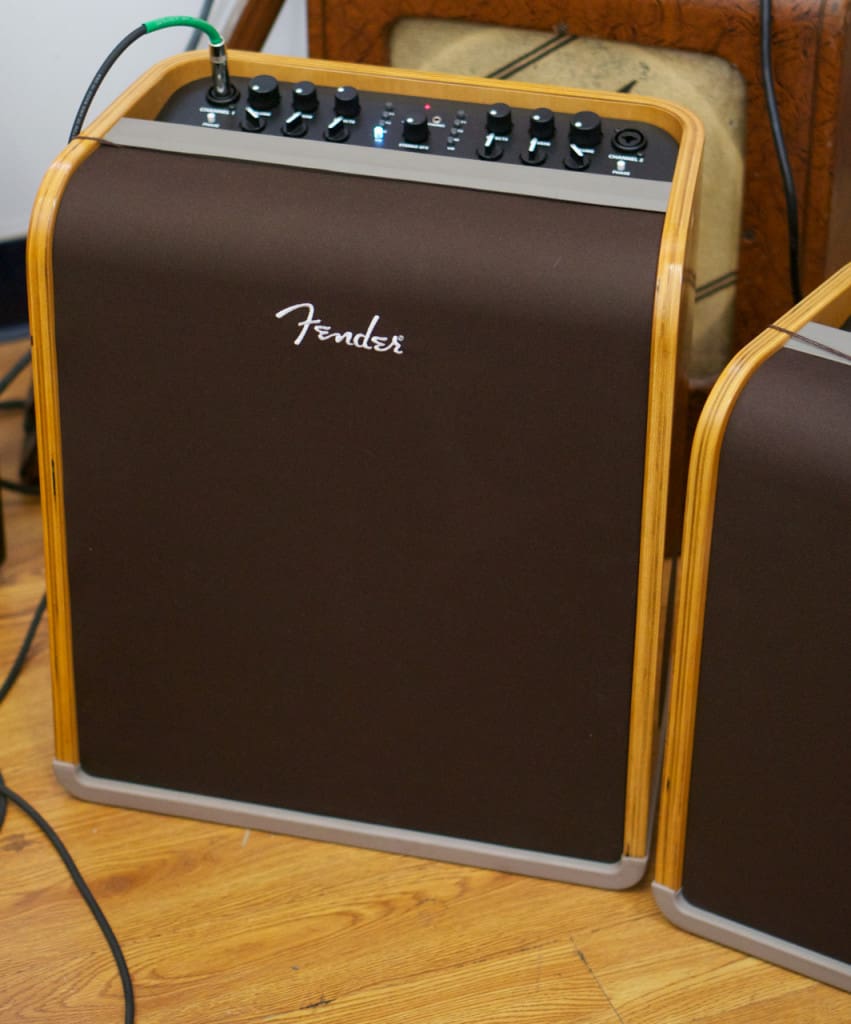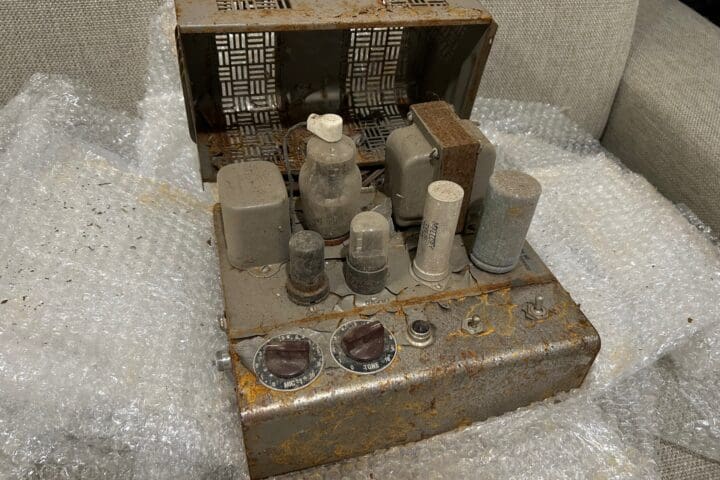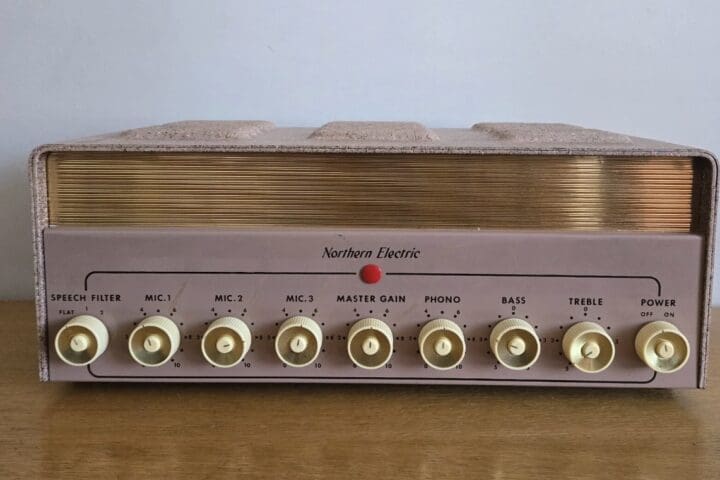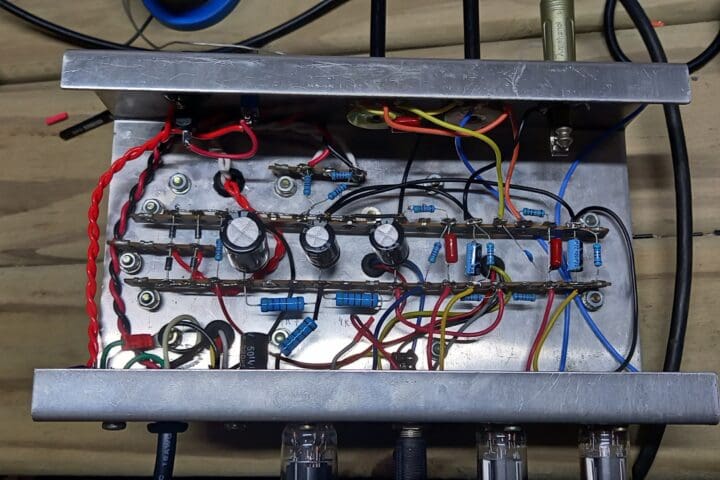Fender has introduced two new amplifiers designed with an eye on the “audiophile” end of the acoustic guitar amp segment. The Acoustic Pro is a burly 200-watt combo with two channels and a single 12″ neodymium speaker; the Acoustic SFX is a more sedate 2×80-watt combo with two channels, an 8″ driver, a 2.5″ tweeter, and an additional 6″ SFX driver, plus four built-in digital effects: two delays, chorus, and “Vibratone” (which sounds an awful lot like vibrato) and that whole “SFX” thing – Stereo Field Expansion technology “which goes beyond stereo for room-filling tonal imagery that envelops the listener in a rich acoustic experience.”
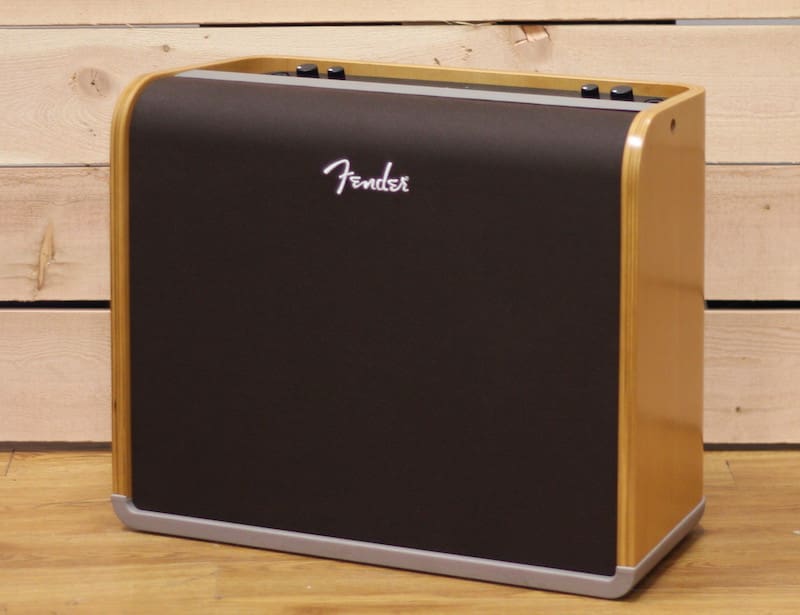
Both amplifiers are housed in handsome bent-maple plywood cabinets, with simple brown cloth grills and built-in handles that Fender notes are capable of holding “personal mobile devices” (the handles are convenient, but they seem to invite you to put a careless thumb through the grill cloth). They also feature built-in reverb, balanced mic/line outputs, headphone outputs, auxiliary inputs, 3-band EQs (the Pro has a sweepable Mid), integrated handles and fitted covers. The inputs for both channels on both amps can be used for instruments or microphones – the jacks can accept both 1/4″ and XLR cables, and the XLR input does provide phantom power for microphones or pre-amps that require it, which is very helpful. Each channel also has a phase switch to aid in reducing feedback. The Pro model features an effects loop and an optional two-button footswitch for bypassing the reverb for both channels. The SFX model has those built-in effects, so no effects loop, and its optional two-button footswitch can be used to bypass the effects for both channels – the reverb cannot be bypassed via footswitch.
Impressions
These amplifiers have a lot going for them, but they also suffer from a few shortcomings, some typical of acoustic guitar amplifiers. They’re light, attractive, and throw a good deal of sound. Their controls are simple, if a little quirky. The 3-band EQs have a wide range, but don’t offer a lot of tone-shaping control. The reverb is a very bright, versatile hall-style that can go from subtle to huge.
The digital effects on the SFX model are simple but effective. They are selected via four individual push buttons. The buttons are tap tempo-enabled and flash in time (delay time or chorus/vibrato frequency) when on. Only one effect can be used at a time (in addition to reverb), and without the footswitch they are enabled/disabled via the Effects level knob. It’s hard to imagine you wouldn’t want the footswitch, so it’s hard to understand why Fender chose to make it optional, except in the interest of pricing ($899 for the SFX, $999 for the Pro) [NOTE: at press time, there does not seem to be a Fender switch specifically for these amps available]. The Stereo Field Expansion has its own level control, but it works in conjunction with the Reverb and Effects levels to determine the degree of the effect. It’s fair to assume that one ought to adjust according to the venue and the situation, but it seems just as likely that folks are going to find a setting they like and use it or not, depending. It was difficult to get much from subtle settings for the SFX, but once we decided to fill the room it did so nicely. It might not be what you expect from an acoustic guitar, but surround sound is pretty cool.
We plugged a diverse batch of instruments into these amplifiers: a parlor-style guitar and a 00 (both with K&K Pure pickups), a slope-shouldered dreadnought with a passive L.R. Baggs M-1 soundhole pickup and even a Collings MT-O mandolin with a K&K. We tried the guitars direct, mic’ed, and both. Everything sounded as good as one might expect from an acoustic guitar amp. Direct the guitars sounded much like you’d expect from this type of setup – that amplified acoustic that doesn’t quite sound acoustic kinda thing. Adding the mic alleviated that considerably. Direct and mic’ed the shortcomings of the EQ were fairly evident, and in general it was hard to do much with the Low and Mid controls without the usual woof one encounters with amplified acoustics.
Once we added a pre-amp with more sophisticated EQ controls to the picture, things improved considerably, (which also suggests that an instrument with an active pickup system would have been much happier from the get-go). Again, this might be expected, but it’s hard not to wonder why it’s expected. If amplifiers for electric guitars and basses offer a way to compensate for active/passive electronics or high-/low-output pickups, why wouldn’t an acoustic guitar amplifier do the same?
Straight out of the box the SFX did pretty well – with its array of smaller speakers it didn’t take much Low cut to back off the woof – but the Pro took some tweaking, particularly when it came to finding a useful Mid frequency. That Pro sure is loud, of course, and will do fine on stage with a full band, but the single 12″ speaker might be a bit much; a full-range solution closer to a slightly upgraded version of the SFX’s driver/tweeter setup might be an improvement. Still, all in all, these are very nice amps. They might not hit “audiophile” dead on, but you’d be hard pressed to argue that any acoustic guitar amplifier does.
